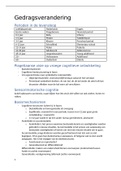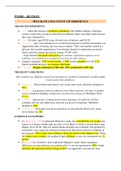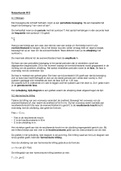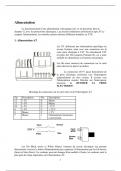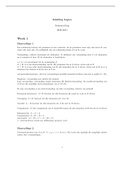Summary of microeconomics
,Inhoud
Table of Contents
H1. The Basics of micro economics.........................................................................................................4
H1.1. types of markets........................................................................................................................4
H1.2. models of micro economics.......................................................................................................5
h.1.2.1. supply and demand...........................................................................................................5
H1.2.2. elasticity.............................................................................................................................7
H1.3. behavioural economics..............................................................................................................8
H2. Consumption and demand...............................................................................................................9
H2.1. consumer behaviour.................................................................................................................9
H2.1.1. consumer preferences........................................................................................................9
H2.1.2. budget constraints............................................................................................................12
H2.1.3. consumer choices.............................................................................................................12
H2.1.4. consumer index................................................................................................................13
H2.2. market demand.......................................................................................................................13
H2.2.1. individual demand............................................................................................................14
H2.2.2. Income..............................................................................................................................14
H2.2.3. market demand................................................................................................................16
H2.2.4. consumer surplus..............................................................................................................16
H2.2.5. networking effects............................................................................................................16
H3. Production and supply...................................................................................................................17
H3.1. production technology............................................................................................................17
H3.2. cost constraints.......................................................................................................................18
H3.2.1. production with one variable input..................................................................................18
H3.2.2. production with two variable input..................................................................................19
H3.3. input choices...........................................................................................................................20
H3.4. cost of production...................................................................................................................20
H3.4.1. short-run versus long-run.................................................................................................21
H3.4.2. cost constraints....................................................................................................................22
H3.4.3. producer choices..................................................................................................................22
H4. Perfect competition........................................................................................................................23
H4.1. Profit maximization.................................................................................................................24
H4.2. Short run.................................................................................................................................24
H4.3. Long run..................................................................................................................................25
H4.4. consumer and producer surplus..............................................................................................25
H5. Monopolistic competition..............................................................................................................26
H6. Oligopoly........................................................................................................................................27
,H7. Monopoly (market power).............................................................................................................28
H7.1. profit maximization.................................................................................................................28
H8. Games and strategy........................................................................................................................30
H9. Market failures and efficiency........................................................................................................32
H9.1. general equilibrium and economic efficiency..............................................................................32
H9.2. asymmetric information..........................................................................................................33
H9.3. externalities and public goods.................................................................................................34
Calculations..........................................................................................................................................36
Graphs..................................................................................................................................................37
Cheat Sheet..........................................................................................................................................41
,H1. The Basics of micro economics
H1.1. types of markets
There are four types of markets, where each has their unique set of characteristics.
Perfect competition Monopolistic Oligopoly monopoly
competition
Price taker Price taker Price setter Price setter
Many firms Many firms Few firms One firm
Very low barriers entry / Low barriers to High barriers to Very high barriers to
exit entry/exit entry/exit entry/exit
Identical products Highly similar products Higher quality products Higher quality products
P=MC P>AC
Transparent information Transparent information Barely transparent No transparent
information information
Producer surplus: price Producer surplus: price
lower, quantity higher higher, quantity lower
Consumer surplus Consumer surplus lower,
higher, price lower, price higher, quantity
quantity higher lower
,H1.2. models of micro economics
h.1.2.1. supply and demand
What is the supply and demand model? The supply and demand model is a representation of the market,
where buyers and sellers meet. The model gives insight in the price and quantity of a certain good.
The simplistic supply and demand model is used for perfect competition.
Supply side (producer)
Shows how much of a good producers are willing to sell at a given price.
Supply function: Qs = S(P)
Inverse supply function: Ps = S-1 (Q)
Lineair supply function: Q= c + dP
Es: c(P/Q)
Supply function: quantity supplied as a function of price
inverse supply function: the price as a function of quantity supplied
shifts in supply side:
number of sellers
price of materials
price of production
technology
Demand side (consumer)
Shows how much of a good consumers are willing to buy at a given price
Demand function: Qd = D(P)
Inverse supply function: Pd = D-1 (Q)
Lineair demand function: Q = a – bP
Ed: -b(P/Q)
Demand function: quantity demand as a function of price
Inverse demand function: the price as a function of quantity demand
Shift in demand side:
Price
Income
price of related goods
tastes
Expectations
population
, Equilibrium
Place where curves intersect
Qs = Qd
No excess demand (lower price, higher quantity)
No excess supply (higher price, lower quantity)
P*= equilibrium price
Q*=equilibrium quantity
Shifts in supply curve and/or demand curve can cause a new equilibrium point (with new
Figure 1: equilibrium
prices and quantities).
market mechanism
The tendency in a free market for prices to change until the market clears.
This happens when there is excess demand or excess supply
Shortage: quantity demand > quantity supply
Surplus: quantity supply > quantity demand
shortage and surplus are the most known examples where market mechanisms pushes the
demand and supply to a new equilibrium .
Other examples are: import and export or taxes and subsidies.
Figure 2: market mechanism
market



